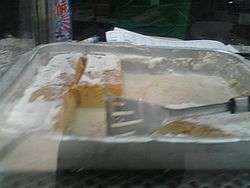Bienmesabe
Bienmesabe (Spanish: "it tastes good to me")[1][2] is a sweet Venezuelan dessert prepared with honey, egg yolk, and ground almonds as primary ingredients. Its consistency significantly varies depending upon preparation methods used. The dessert is also popular in the cuisine of the Canary Islands. It has been described as influenced by Moorish cuisine. Several variations of the dessert exist.

Overview

Honey, egg yolk and ground almonds are primary ingredients in the preparation of bienmesabe,[3] and some versions are prepared using sugar. Additional ingredients may include lemon zest, cinnamon and sweet wine or sherry.[1]
Bienmesabe's consistency varies greatly depending upon preparation methods, and can vary from the consistency of a sticky sauce[4] thick cream[1] or meringue[5] to a custard or cake.[6] Well-chilled versions may have a toffee-like consistency.[1] As a sauce, bienmesabe is sometimes served poured over ice cream.[4][7]
Canary Islands
Bienmesabe is a popular dessert in the cuisine of the Canary Islands,[7][8][9] where it is served with cat's tongue cookies. The cookies may be served on the side or crushed and served atop the dessert.[1] On the Canary Islands, the dish may also include rum.[10] It has been described as the "most famous" dessert in Canarian cuisine.[10]
History
Bienmesabe a traditional Venezuelan dessert has been described as being influenced by the cuisine of the Moors.[5]
Variations

Panama
In Panamanian cuisine, bienmesabe is a dessert dish prepared using milk, rice and panela (unrefined whole cane sugar), which is slow cooked.[11]
Puerto Rico
In Puerto Rican cuisine, bienmesabe is a sweet syrup prepared using coconut milk, egg yolk, rum and sugar. It is used poured atop dishes such as ladyfingers, sponge cake fingers and okra.[12]
Spain
Bienmesabe antequerano is prepared in a marzipan cake form, which has a soft texture and is topped with sugar.[13]
Venezuela
In Venezuelan cuisine, bienmesabe is a traditional cake prepared using coconut and liqueur.[14] A sweet sponge cake version that is soaked in a mixture of egg yolks and coconut milk exists as well.[15]
See also
References
- Daft, R. (2008). Menu Del Dia: More Than 100 Classic, Authentic Recipes From Across Spain. Simon & Schuster. p. 140. ISBN 978-1-4165-7961-8.
- Moyna, M.I. (2011). Compound Words in Spanish: Theory and History. Amsterdam studies in the theory and history of linguistic science / 4. John Benjamins Publishing Company. p. 61. ISBN 978-90-272-4834-3.
- eatingtheglobe (17 August 2015). "Lanzarote – A Much Underrated Foodie's Paradise". Eating The Globe-Food and Travel. Archived from the original on 5 May 2019. Retrieved 10 September 2015.
- Casas, P. (2014). 1,000 Spanish Recipes. 1,000 Recipes. Houghton Mifflin Harcourt. p. 662. ISBN 978-0-544-30908-1.
- (Firm), Michelin Travel Publications (2004). Andalucia. Michelin green guides. Michelin Travel Publications. p. 133.
... the almond- flavoured, meringue-like bienmesabe, a Moorish-influenced dessert.
- Corne, L. (2004). Canary Islands. Bradt Guides. Bradt Travel Guides. p. 49. ISBN 978-1-84162-108-1. Retrieved September 10, 2015.
- "The lap of luxury on an isle that's a perfect 10". Independent.ie. 10 September 2015. Retrieved 10 September 2015.
- Barrenechea, T.; Koehler, J.; Hirsheimer, C. (2013). The Cuisines of Spain: Exploring Regional Home Cooking. Potter/TenSpeed/Harmony. p. PT 83. ISBN 978-1-60774-615-7.
- Berlitz: Canary Islands Pocket Guide. Berlitz Pocket Guides. APA. 2015. p. 128. ISBN 978-1-78004-889-5.
- Inman, N.; Murphy, P. (2007). Travellers Gran Canaria and Tenerife. Thomas Cook travellers. Thomas Cook Publishing. p. 157. ISBN 978-1-84157-816-3.
- Humphreys, S. (2010). The Rough Guide to Panama. Rough Guide to... Rough Guides. p. 260. ISBN 978-1-4053-8809-2.
- Levy, P.; Bahrawi, N. (2005). Puerto Rico. Cultures of the world (in Italian). Marshall Cavendish Benchmark. p. 125. ISBN 978-0-7614-1970-9. Retrieved September 10, 2015.
- Facaros, D.; Wayne, J.; Pauls, M. (1996). Lazy Days Out in Andalucia. Cadogan Food Lovers'/Gourmet Guides: Lazy Days. Cadogan Guides. p. 25. ISBN 978-1-86011-060-3.
You'll do no better than bienmesabe antequerano, a soft marzipan cake with sugar and the ubiquitous almond...
- Fodor's Travel Publications, I.; Kidder, L.; Kealy, K.; Duecy, E. (2008). Fodor's South America. Fodor's South America. Fodor's Travel Publications. p. 725. ISBN 978-1-4000-0686-1.
- Business Venezuela. Venezuelan-American Chamber of Commerce of Venezuela. 1994. p. 67.